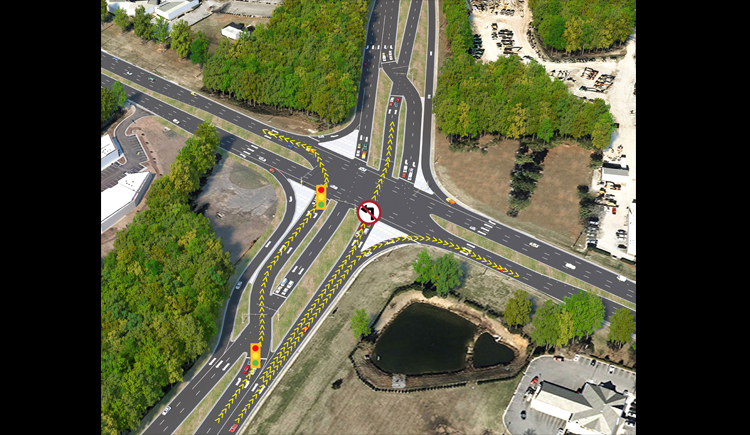A continuous flow intersection (sometimes referred to as a displaced left-turn intersection) improves traffic flow and reduces delays by allowing left turns and through movements of one or both approaches to occur at the same time.
Using a Continuous Flow Intersection
Pedestrians, Heads-Up!
People should watch for signs indicating the direction of traffic and look both ways while progressing through the set of crosswalks, which have signal heads to tell people when to walk or wait.
Caution is needed because drivers will come from either direction as pedestrians navigate from one side of the intersection to another.
Drivers travel through the intersection as follows:
- To go straight, they proceed as normal when the signal is green.
- To go right, they travel as normal, turning right when it’s clear and safe to do so.
- To go left, drivers make the turn earlier – before reaching the main intersection. Motorists should follow the signs and road markings to cross over the opposing through lanes at a traffic signal, which is typically 300 to 500 feet before the main intersection. Then, drivers turn left when the light is green.
- Note: Drivers turning right from the other direction will have a free-flowing lane and, typically, merge into traffic that has gone straight through the intersection.

In this design, drivers turn left before they reach the main intersection. This shift allows left-moving traffic and opposing drivers going straight to pass through the main intersection at the same time, reducing travel delays.
Traffic Capacity
The ability of an intersection to handle, or process, the volume of vehicles passing through it is known as traffic capacity. Generally, the higher the capacity, the more vehicles per hour an intersection can process.
A continuous flow intersection has the highest capacity that the NCDOT can construct without building a bridge.
Most of the delays at intersections with traffic signals are due to left-turning movements. By simultaneously moving left-turning vehicles and opposing traffic at the same time, the number of signal phases can be reduced – thus, reducing delays and boosting the intersection’s capacity to move traffic.
Additionally, a continuous flow intersection is versatile in how it can be designed. The design can work for a T-intersection, for instance, and for any number – or all – directions of a four-legged intersection.
Study Indicates Travel Time Savings
A computer simulation study conducted by the Federal Highway Administration in 2009 showed that a typical continuous flow intersection like the one
NCDOT opened in Charlotte in 2019 reduces the average delay to a motorist during rush hour by about 35 percent.
Other Benefits of the Design
- The design reduces slightly the number of locations, or conflicts, where a crash can occur. A 2015 study by the Utah Department of Transportation found the design reduced crashes by an average of 12 percent.
- Unlike most intersections, a continuous flow design works better with junctions that have heavy demand for left-turning traffic.
- Although this design requires that traffic signals be added several hundred feet from the intersection, their added location makes it easy to process a high volume of vehicles. Thus, most motorists stop no more than once going through the intersection.
- Only a bridge yields a better traffic capacity than a continuous flow intersection. However, designing and building a bridge costs more money, takes more time and impacts more property than developing a continuous flow intersection.
History of Continuous Flow Intersections
The design was first used in the United States in 1995. Today, there are more than 30 across the U.S.
In the fall of 2019, NCDOT opened its first continuous flow intersection in Charlotte. The department is planning about a half-dozen more across the state.